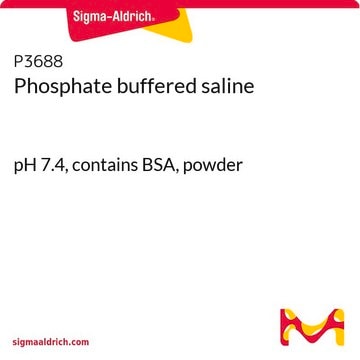11633716001
Roche
Anti-Digoxigenin-POD (poly), Fab fragments
from sheep
Synonym(s):
anti-digoxigenin, digoxigenin
About This Item
Recommended Products
biological source
sheep
Quality Level
conjugate
peroxidase conjugate
antibody form
purified immunoglobulin
antibody product type
primary antibodies
clone
polyclonal
form
lyophilized
packaging
pkg of 50 U
manufacturer/tradename
Roche
isotype
IgG
storage temp.
2-8°C
General description
Specificity
Application
- whole-mount in situ hybridization
- fluorescence in situ hybridization
- enzyme linked immunosorbent assay (ELISA)
- dot blot
- Southern blot
- western blot
- double labeling experiments
- lectin blots
Anti-Digoxigenin-POD (poly), Fab fragments give considerably higher signal-to-noise values compared to anti-Digoxigenin-Fab fragment conjugated to the unpolymerized horseradish peroxidase in ELISA applications. It is specifically useful when high sensitivity is required.
Anti-Digoxigenin-POD (poly), Fab fragments have not been evaluated in immunohistochemistry.
Preparation Note
- Dot blot: 50 to 100 mU/ml
- ELISA: 2 to 50 mU/ml
- Western blot: 50 to 100 mU/ml
- Southern blot: 50 to 100 mU/ml
Working solution: 100 mM Tris-HCl, 150 mM NaCl, pH 7.5.
1% Blocking reagent (w/v), 1 to 5% heat inactivated fetal calf serum (v/v) or sheep normal serum can be used for reduction of unspecific binding.
Reconstitution
Other Notes
Not finding the right product?
Try our Product Selector Tool.
signalword
Warning
hcodes
Hazard Classifications
Skin Sens. 1
Storage Class
11 - Combustible Solids
wgk_germany
WGK 1
flash_point_f
does not flash
flash_point_c
does not flash
Choose from one of the most recent versions:
Already Own This Product?
Find documentation for the products that you have recently purchased in the Document Library.
Customers Also Viewed
Articles
Digoxigenin (DIG) labeling methods and kits for DNA and RNA DIG probes, random primed DNA labeling, nick translation labeling, 5’ and 3’ oligonucleotide end-labeling.
Our team of scientists has experience in all areas of research including Life Science, Material Science, Chemical Synthesis, Chromatography, Analytical and many others.
Contact Technical Service











